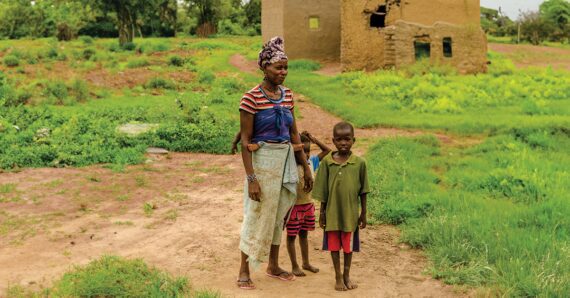The global hunger crisis has worsened over the past two years. As 2023 draws to a close, Bread for the World members join anti-hunger advocates globally in advocating for urgent assistance for hundreds of millions of people who are facing acute hunger and malnutrition. It can be difficult to gather data on their precise numbers in contexts like refugee camps and communities that are trapped between fighting factions, but the most recent estimates range from 333 million to 363 million people.
Another article in this hunger hotspots series discusses the impossible decisions necessitated by this year’s significant shortfalls in humanitarian funding.
The most recent Hunger Hotspots outlook, prepared by the World Food Programme (WFP) and the Food and Agriculture Organization (FAO), is for the period November 2023 through April 2024.
The hunger hotspots designated as “of highest concern” currently are South Sudan, Sudan, Burkina Faso, Mali, and Palestine. In all five countries, urgent humanitarian action is critical to prevent additional starvation deaths.
You can read more about South Sudan and Sudan in the Hunger Hotspots series.
In the Sahel regional hunger hotspot, which includes Burkina Faso and Mali, more than 45,000 people are already facing famine, while millions of others are on the verge of famine. Violent conflict is driving acute hunger and malnutrition in both countries. Between July 2023 and September 2023, 22 percent of all conflict-related deaths worldwide were in the Sahel region.
Palestine was added to this list after conflict escalated sharply in October 2023. Ongoing hostilities in the Gaza Strip are expected to further exacerbate the already urgent and severe humanitarian needs of the population. As in Sudan, there is potential for the conflict to widen and affect others in the surrounding region.
Another group of eight countries that are currently considered hunger hotspots “of very high concern” includes Afghanistan, the Democratic Republic of the Congo, Ethiopia, Haiti, Pakistan, Somalia, Syria, and Yemen. They are described as countries that have both at least half a million people on the verge of famine, and “critical deteriorating conditions.” Because conditions are expected to worsen over the next several months, urgent action is needed to prevent hundreds of thousands of people from suffering extreme hunger in situations that are life-threatening.
Conditions in Haiti illustrate what humanitarian agencies mean by a hunger hotspot “of very high concern.” Rising levels of violence and insecurity and a protracted economic crisis, combined with poor harvests and the potential impact of hurricanes, make it likely that already critical levels of acute food insecurity will worsen. Between March 2024 and June 2024, it is expected that an an estimated 1.4 million people in Haiti will be living on the verge of famine. In some parts of the country, 30 percent of the population is severely malnourished.
Along with five hunger hotspots of highest concern and eight hunger hotspots of very high concern, the following five regions or countries complete the list of 18 hunger hotspots: Central America (Guatemala, Honduras, El Salvador, and Nicaragua), Central Sahel (Niger and Chad), Djibouti, Malawi, and Zimbabwe.
The WFP/FAO update notes that high levels of acute food insecurity impact not only the hunger hotspots but a number of additional countries. Earlier hunger hotspot reports also mention acute hunger situations apart from those on the list of hunger hotspots. But the new update includes, in its list of countries that are not currently hunger hotspots, yet “also require monitoring,” several that had been hunger hotspots recently.
The “to be monitored” list is composed of the Cox’s Bazaar area of Bangladesh, Myanmar, Colombia, Venezuela, Timor-Leste, Lebanon, Nigeria, and Uganda.
The main distinction between this group and the current hunger hotspots, the report explains, is that hunger and malnutrition in the countries in this group do not appear to be rapidly worsening. It is the hunger hotspots that are expected to suffer significant deterioration in food security conditions this coming winter and spring. Moreover, the report data makes it clear that when a country is no longer considered a current hunger hotspot, this does not necessarily mean that the hunger crisis is “over” or even improving.
It is not hopeful that people in so many countries are trapped in hunger and malnutrition crises. Still, solving a problem is not possible without an understanding of its extent and causes, and Bread for the World remains steadfast in our advocacy for policies that will end hunger—for everyone, leaving no one behind.
Michele Learner is managing editor, Policy and Research Institute, with Bread for the World.



